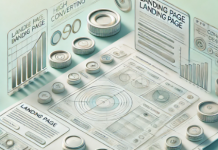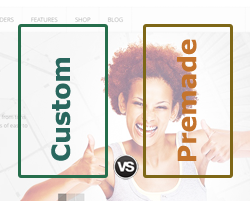 User Experience (UX) design isn’t just the responsibility of designers—it’s a fundamental part of marketing. Why? Because no matter how brilliant your marketing campaigns are, if users land on a website that’s confusing, slow, or frustrating to navigate, they won’t convert. In today’s digital landscape, great UX equals better conversions.
User Experience (UX) design isn’t just the responsibility of designers—it’s a fundamental part of marketing. Why? Because no matter how brilliant your marketing campaigns are, if users land on a website that’s confusing, slow, or frustrating to navigate, they won’t convert. In today’s digital landscape, great UX equals better conversions.
Whether you’re optimizing landing pages, running paid ads, or improving your website’s flow, understanding UX principles will help you create seamless experiences that turn visitors into customers. This guide dives deep into essential UX design principles every marketer should know, backed by real-world examples, actionable tips, and strategies to drive meaningful results.
What Is UX Design, and Why Should Marketers Care?
UX design is about how users interact with your website, product, or service. It covers everything from site navigation and visual design to content clarity and load speed. For marketers, UX impacts:
- Conversion Rates: A smooth, intuitive experience reduces friction, encouraging users to take action.
- SEO Performance: Google’s algorithms prioritize websites with strong UX signals like fast load times and low bounce rates.
- Customer Retention: Positive user experiences lead to repeat visits and long-term loyalty.
Core UX Design Principles Every Marketer Should Know
1. Clarity Over Cleverness
While creativity is essential in marketing, clarity should always come first in UX design. Users should immediately understand:
- What your website offers
- Why it’s valuable to them
- What action they should take next
Example: Instead of using vague headlines like “Discover the Future,” say “Get Your Free SEO Audit Today.”
2. Visual Hierarchy Guides User Attention
Visual hierarchy refers to how you organize content to guide users’ eyes toward key information. Use:
- Headings: Larger, bold fonts to emphasize important points.
- Color Contrast: Bright buttons on neutral backgrounds for CTAs.
- Whitespace: Don’t clutter; give elements room to breathe.
<h1 style=”font-size: 32px; font-weight: bold;”>Boost Your Sales with Our Marketing Tools</h1>
3. Consistency Builds Trust
Consistent design across your website creates a sense of reliability. This includes:
- Uniform typography and color schemes
- Consistent button styles and icons
- Predictable navigation menus
4. Speed Matters—A Lot
In UX, speed isn’t just about convenience—it’s a necessity. Studies show that a 1-second delay in load time can reduce conversions by 7%.
Tip: Use tools like Google PageSpeed Insights to identify performance bottlenecks and optimize load times.
5. Mobile-First Design Is Non-Negotiable
With more than 50% of web traffic coming from mobile devices, your site must look and function flawlessly on smartphones.
<meta name=”viewport” content=”width=device-width, initial-scale=1″>
6. Accessibility Is Part of Good UX
Designing for accessibility isn’t just ethical; it broadens your audience. This includes:
- Using alt text for images
- Ensuring color contrast for readability
- Keyboard-friendly navigation
7. Simplify Navigation
Users should never feel lost. Keep navigation simple and intuitive:
- Use clear labels like “Pricing,” “Features,” or “Contact Us.”
- Limit menu items to reduce cognitive load.
- Ensure important pages are accessible within 2–3 clicks.
Advice: Add a sticky navigation bar for easy access to key pages, especially on long scrolling pages.
How UX Design Influences Conversions
1. Clear Calls-to-Action (CTAs)
Your CTA should stand out and communicate exactly what happens when clicked.
<button style=”background-color: #FF5733; color: white;”>Get Started Free</button>
2. Reduce Friction in Forms
Long forms can deter users. Simplify by:
- Only asking for essential information
- Using auto-fill where possible
- Breaking long forms into multi-step processes
3. Leverage Social Proof
Adding testimonials, reviews, or case studies builds trust and reduces hesitation.
“Since using [Your Product], our conversions have doubled!” — Happy Customer
Real-World Example: UX-Driven Conversion Boost
A SaaS company struggled with a high bounce rate despite running successful ad campaigns. Here’s how they improved:
- Problem: Complex pricing page with too much text.
- Solution: Simplified the layout, added clear CTAs, and showcased customer testimonials.
- Result: A 40% increase in conversions within two months.
Common UX Mistakes to Avoid
- Ignoring Mobile Users: Test your site on various devices.
- Overcomplicating Navigation: Keep menus straightforward.
- Slow Load Times: Optimize images and code.
- Unclear CTAs: Make them bold, visible, and action-oriented.
- Inconsistent Design: Maintain visual harmony across pages.
Expert Tips for Marketers to Improve UX
- Conduct User Testing: Get real feedback from users to identify pain points.
- Analyze Heatmaps: Tools like Hotjar show where users click and scroll the most.
- A/B Test Landing Pages: Compare variations to see which design converts better.
- Focus on Micro-Interactions: Subtle animations or hover effects can enhance the user experience.
Conclusion
UX design isn’t just a design concern—it’s a marketing superpower. When marketers understand and apply UX principles, they create experiences that not only attract users but also convert them. By focusing on clarity, consistency, speed, and simplicity, you’ll not only improve conversion rates but also build lasting relationships with your audience.
Remember, great UX is invisible—it feels natural, intuitive, and effortless. That’s the secret to turning casual visitors into loyal customers.












